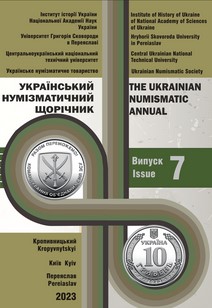АНТИЧНА НУМІЗМАТИКА ТА МОНЕТНА СПРАВА БОСПОРУ У ФРАНКОМОВНІЙ ІСТОРІОГРАФІЇ XIX СТ.
ANCIENT NUMISMATICS AND COINAGE OF THE BOSPORUS IN THE FRANCOPHONE HISTORIOGRAPHY OF THE XIX CENTURY
Author(s): Kristina YahuzhynskaSubject(s): Archaeology, Economic history, Ancient World, 19th Century
Published by: ДВНЗ Переяслав-Хмельницький державний педагогічний університет імені Григорія Сковороди
Keywords: Bosporus; Bosporus Kingdom; numismatics; coins; collections; historiography;
Summary/Abstract: Historiographic analysis of historical and numismatic publications of French-speaking researchers of the XIX century, devoted to ancient history, including the history of the Bosporan Kingdom, acquires relevance in the context of the development of European ancient numismatics, expanding the circle of francophones investigators of the past, whose works retain informative value relevance. The purpose of this article is to determine and explore the stages of development of ancient numismatics and coinage of the Bosporus in the French-language discourse of the XIX century. It is possible to distinguish 3 areas of scientific research on coinage and monetary history of the Bosporus in francophone sources of the XIX century: 1) the study of antique annals and collecting; 2) archaeological research and their materials; 3) germ of a theoretical comprehension of numismatic material, including the development of typological series, editions of descriptive and illustrated catalogs, based on new classifications of coins, grouped in chronological order etc. Accordingly, researchers who adhered to the first direction, writing historical works on the political and military history of the ancient world, also collecting fragmentary facts of the economic history of the Bosporus, its coinage and money circulation, relied on the works of such ancient authors as Strabo, Aelian, Justin, Lucian of Samosata. The lack of information content of the historical written sources known at that time caused the need to use the material of numismatic collections as historical sources. For example, a brilliant 15-volume catalog with a description of more than 52 thousand Roman and Greek coins, edited by E. Mionne, employee of the Cabinet des Médailles in Paris. The scientist has invented a scale of measurements of the diameter of coins (the Mionne scale) during his extensive numismatic studies. The second direction – archaeological research, was intended to replenish and expand the material base of existing collections, to lay the foundations for future collections of newly created museums. Representatives of the archaeological direction are a galaxy of archaeologists of Swiss origin – the Crimean ethnographer Louis Colly, the archaeologist, traveler, naturalist – Dubois de Montpere, the Luxembourg nobleman Paul Du Brux – the archaeologist-discoverer of many cities of the Bosporan Kingdom and the co-organizer of the Kerch Museum of Antiquities. Since the middle of the XIX century numismatics as a science has become a university discipline and its theoretical comprehension of the main concepts was formed. Findings of written, archaeological sources, descriptions of private and official collections were systematized, fundamental catalogs were created. A significant development of the third – the theoretical direction, is connected inextricably with outstanding historians, archaeologists and numismatists, among which there are: Swiss numismatist and traveler Imhof Bloomer (1836–1920), French researchers – brothers Reinach Salomon (1858–1932) and Theodor (1860–1928). These researchers presented rich factual material to study not only ancient history as a whole, but also the economic history and numismatics of the Cimmerian Bosporus. The theoretical direction was finally formed in the last quarter of the XIX century and was characterized not only by quoting and criticizing ancient sources, but also by the fact that the events of the past begin to be covered taking into account new discoveries in archeology – monuments of epigraphy and numismatics. Moreover, publications, dedicated to the history of Bosporus dynasties, relations with the Roman Empire, were based exclusively on information from numismatics and epigraphy. At this time, numismatic societies appeared: one of the oldest – the Belgian Royal Numismatic Society (1841), the numismatic society of France (1865). They offered to public`s attention specialized scientific journals "Revue Numismatique" (1836) in Paris, a French language edition "Revue de la numismatique belge" in Belgium (1842), following accurately to the pan-European trends in the development of numismatics.
Journal: Український Нумізматичний Щорічник
- Issue Year: 2023
- Issue No: 7
- Page Range: 247-257
- Page Count: 11
- Language: Ukrainian

